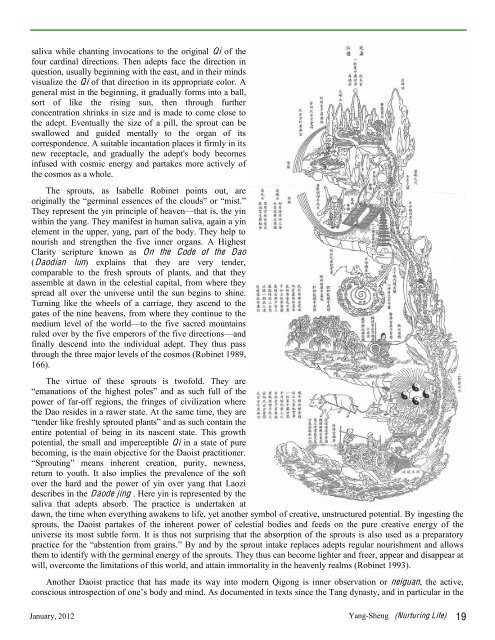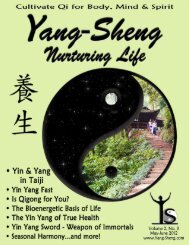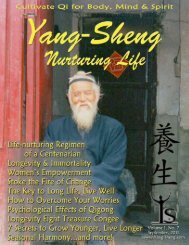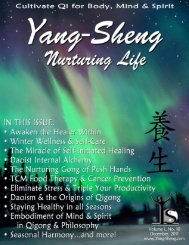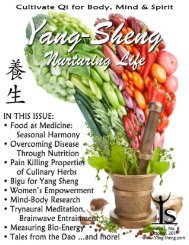Download PDF - Yang-Sheng
Download PDF - Yang-Sheng
Download PDF - Yang-Sheng
Create successful ePaper yourself
Turn your PDF publications into a flip-book with our unique Google optimized e-Paper software.
saliva while chanting invocations to the original Qi of the<br />
four cardinal directions. Then adepts face the direction in<br />
question, usually beginning with the east, and in their minds<br />
visualize the Qi of that direction in its appropriate color. A<br />
general mist in the beginning, it gradually forms into a ball,<br />
sort of like the rising sun, then through further<br />
concentration shrinks in size and is made to come close to<br />
the adept. Eventually the size of a pill, the sprout can be<br />
swallowed and guided mentally to the organ of its<br />
correspondence. A suitable incantation places it firmly in its<br />
new receptacle, and gradually the adept's body becomes<br />
infused with cosmic energy and partakes more actively of<br />
the cosmos as a whole.<br />
The sprouts, as Isabelle Robinet points out, are<br />
originally the “germinal essences of the clouds” or “mist.”<br />
They represent the yin principle of heaven—that is, the yin<br />
within the yang. They manifest in human saliva, again a yin<br />
element in the upper, yang, part of the body. They help to<br />
nourish and strengthen the five inner organs. A Highest<br />
Clarity scripture known as On the Code of the Dao<br />
(Daodian lun) explains that they are very tender,<br />
comparable to the fresh sprouts of plants, and that they<br />
assemble at dawn in the celestial capital, from where they<br />
spread all over the universe until the sun begins to shine.<br />
Turning like the wheels of a carriage, they ascend to the<br />
gates of the nine heavens, from where they continue to the<br />
medium level of the world—to the five sacred mountains<br />
ruled over by the five emperors of the five directions—and<br />
finally descend into the individual adept. They thus pass<br />
through the three major levels of the cosmos (Robinet 1989,<br />
166).<br />
The virtue of these sprouts is twofold. They are<br />
“emanations of the highest poles” and as such full of the<br />
power of far-off regions, the fringes of civilization where<br />
the Dao resides in a rawer state. At the same time, they are<br />
“tender like freshly sprouted plants” and as such contain the<br />
entire potential of being in its nascent state. This growth<br />
potential, the small and imperceptible Qi in a state of pure<br />
becoming, is the main objective for the Daoist practitioner.<br />
“Sprouting” means inherent creation, purity, newness,<br />
return to youth. It also implies the prevalence of the soft<br />
over the hard and the power of yin over yang that Laozi<br />
describes in the Daode jing . Here yin is represented by the<br />
saliva that adepts absorb. The practice is undertaken at<br />
dawn, the time when everything awakens to life, yet another symbol of creative, unstructured potential. By ingesting the<br />
sprouts, the Daoist partakes of the inherent power of celestial bodies and feeds on the pure creative energy of the<br />
universe its most subtle form. It is thus not surprising that the absorption of the sprouts is also used as a preparatory<br />
practice for the “abstention from grains.” By and by the sprout intake replaces adepts regular nourishment and allows<br />
them to identify with the germinal energy of the sprouts. They thus can become lighter and freer, appear and disappear at<br />
will, overcome the limitations of this world, and attain immortality in the heavenly realms (Robinet 1993).<br />
Another Daoist practice that has made its way into modern Qigong is inner observation or neiguan, the active,<br />
conscious introspection of one’s body and mind. As documented in texts since the Tang dynasty, and in particular in the<br />
January, 2012 <strong>Yang</strong>-<strong>Sheng</strong> (Nurturing Life) 19


